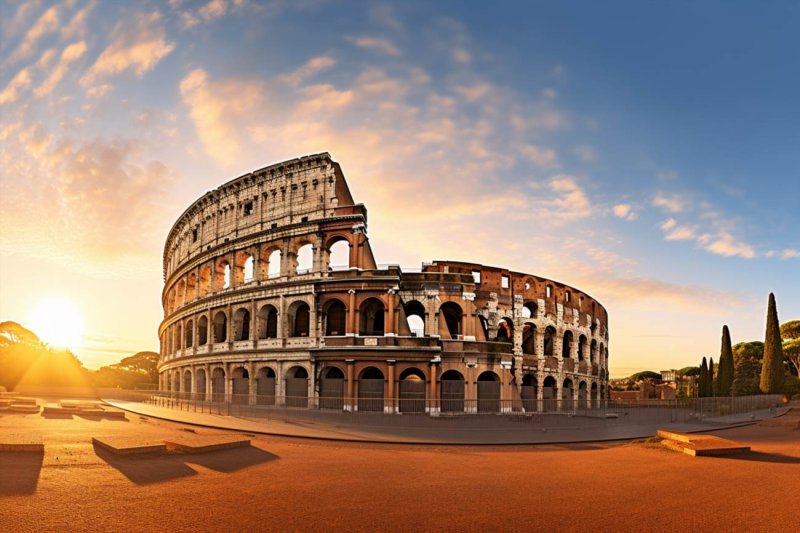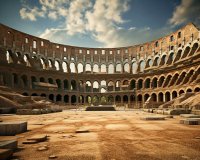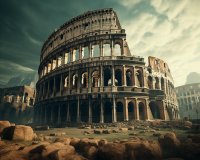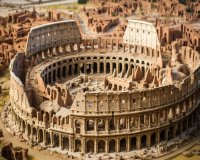Bypass the Lines: Colosseum, Palatine, and Forum in One Go

Bypass the Lines: Colosseum, Palatine, and Forum in One Go, Rome
When visiting the iconic landmarks of Rome, the Colosseum, Palatine Hill, and the Roman Forum, you're in for an unforgettable journey through the history of the Roman Empire. However, the long lines at these sites can be a major hassle, and the hours spent waiting could be better used exploring the wonders of ancient Rome. Fortunately, there are ways to bypass the lines and make the most of your time in this historic city.
Skip-the-Line Tickets
If you're looking to make the most of your visit and avoid the queues, purchasing skip-the-line tickets is the way to go. These tickets allow you to enter the Colosseum, Palatine Hill, and the Roman Forum without waiting in the standard admission lines. It's a time-saving and convenient option for anyone eager to explore these incredible sites.
Guided Tours
Another fantastic way to bypass the lines is by joining a guided tour. Guided tours not only provide skip-the-line access but also offer you the opportunity to learn about the historical significance of these sites from knowledgeable guides. It's like having a personal historian with you to explain the stories and secrets behind the Colosseum, Palatine Hill, and the Roman Forum.
Combo Tickets
If you're planning to explore all three sites in one day, consider purchasing a combo ticket. These tickets often include entry to the Colosseum, Palatine Hill, and the Roman Forum, allowing you to see them all without needing to buy separate tickets for each location. Combo tickets can save you both time and money, making your visit more efficient.
Early Morning or Late Afternoon Visits
If you prefer a more flexible approach and want to explore the Colosseum, Palatine Hill, and the Roman Forum on your own, consider visiting during off-peak hours. Early morning and late afternoon visits can be less crowded, which means shorter waiting times. You'll have the opportunity to soak in the atmosphere and history with fewer fellow tourists around.
Plan Ahead
Regardless of the method you choose to bypass the lines, planning your visit ahead of time is essential. Make sure to check the opening hours, availability of skip-the-line tickets or tours, and any specific entry requirements. Having a well-thought-out itinerary will ensure a smooth and enjoyable visit to these remarkable ancient sites.
Don't let long lines deter you from experiencing the grandeur of the Colosseum, the beauty of Palatine Hill, and the historical richness of the Roman Forum. With the right approach, you can maximize your time and truly immerse yourself in the wonders of ancient Rome.
So, make the most of your trip to Rome and bypass those lines to explore the Colosseum, Palatine Hill, and the Roman Forum seamlessly!
Rome Guided Tour: Explore Colosseum, Forum, Palatine Hill
Embark on a journey through time with our expert local guide on this Skip-the-Line tour to the iconic Colosseum, Roman Forum, and Palatine Hill. Immerse yourself in the rich history of Rome as you discover its ancient wonders.
Highlights:
- Gain priority access to the Colosseum, Forum, and Palatine Hill
- Enjoy a 2.5-hour guided tour with a professional local expert
- Experience the Colosseum from a 360° panoramic vantage point
- Explore the Roman Forum, a hub of ancient government buildings
- Ascend Palatine Hill for stunning views of the Circus Maximus
Skip the ticket line and delve into the Colosseum's history, following the footsteps of gladiators. Your guide will provide insights into the lives of ancient Romans, painting a vivid picture of the once bustling marketplace at the Forum Magnum.
Ascend Palatine Hill, standing 40 meters above the Roman Forum, and marvel at the ancient city's panorama. This small-group tour ensures an intimate experience and ample opportunities for photos.
Includes:
- Professional tour guide
- Headsets for clear guide narration
- Entry tickets to Colosseum, Roman Forum, and Palatine Hill
- Food and drinks
- Tips
Not suitable for individuals with back problems, mobility impairments, or wheelchair users. Select your preferred language (Spanish, English, German, French, Italian) and book your spot today without payment, keeping your travel plans flexible.
Meeting Point: The meeting point varies based on the chosen option, such as Spanish or English Small-Group Tours or German Group Tours. Please check availability for details.
Important Information:
- Bring passport or ID card
- Dress comfortably
- Prohibited items include pets, weapons, large bags, alcohol, drugs, sprays, aerosols, glass objects, and explosive substances
Know Before You Go: This tour operates in all weather conditions.
The History and Significance of the Colosseum in Rome
The Colosseum, also known as the Flavian Amphitheatre, is one of the most iconic and well-preserved ancient structures in Rome, Italy. Its history and significance are deeply rooted in the heart of Roman civilization, and it continues to captivate the world as a symbol of ancient engineering and entertainment.
The construction of the Colosseum began in AD 70-72 under the emperor Vespasian and was completed in AD 80 by his son Titus. This grand amphitheater was primarily designed for hosting various forms of public spectacles, including gladiatorial contests, animal hunts, mock sea battles, and executions. Its colossal size, capable of accommodating up to 80,000 spectators, showcased the wealth and power of the Roman Empire.
With its elliptical shape and four stories of travertine and concrete, the Colosseum was a marvel of ancient engineering. The exterior was adorned with statues and decorative elements, and the interior had a complex system of tunnels and chambers used to stage events and provide access for participants and animals. The arena floor was covered with sand, "harena" in Latin, which is said to be the origin of the term "arena."
| Key Facts about the Colosseum |
| Location |
Rome, Italy |
| Construction Period |
AD 70-80 |
| Capacity |
Up to 80,000 spectators |
| Materials Used |
Travertine, concrete, and iron clamps |
| Primary Use |
Entertainment venue |
The Colosseum's significance goes beyond its architectural and engineering marvels. It was a central hub for Roman society, offering a space for entertainment and social gatherings, but also serving as a symbol of imperial power and control. The events held here, often gruesome and brutal by modern standards, were an essential tool for emperors to maintain control and divert the public's attention from political matters.
Over the centuries, the Colosseum underwent several modifications and faced damage from natural disasters, but it remained a symbol of Rome's enduring legacy. In the Middle Ages, it was repurposed for various uses, including housing, workshops, and even a fortress. In the 18th century, efforts to preserve and restore the Colosseum began, and it became a symbol of the city's rich history and cultural heritage.
Today, the Colosseum stands as a UNESCO World Heritage Site and a must-visit attraction for tourists from around the world. It continues to be a symbol of Rome's grandeur, its enduring architectural achievements, and a reminder of the past events that unfolded within its massive walls.
Conclusion
The Colosseum in Rome is not just a historical relic; it is a testament to the remarkable engineering and cultural significance of ancient Rome. Its enduring presence in the heart of the city is a reminder of the power, innovation, and entertainment that once defined the Roman Empire. Today, it stands as a symbol of the eternal city and a remarkable testament to human ingenuity and history.
Rome: Colosseum Exploration Tour
Embark on a captivating journey through history with our Rome: Colosseum Exploration Tour. Join your knowledgeable guide as you traverse the iconic Colosseum's arena floor, the historic Roman Forum, and the majestic Palatine Hill.
Discover the intriguing lives of ancient gladiators, delving into their training routines and living conditions. Walk through the Gladiators’ Gate, imagining the roaring crowds that once filled this deadly arena. Gain exclusive access to the Colosseum’s arena floor, where you'll witness the intricate engineering systems that brought awe-inspiring spectacles to life.
Learn about the feats of ancient Roman engineering, from making animals seemingly appear out of thin air to the conditions where both man and beast spent their final hours before becoming part of the show. Ascend the Palatine Hill for breathtaking views of the expansive city below.
Explore the triumphal arches of two powerful emperors, Titus and Constantine, testaments to the might of one of history’s greatest empires. Choose between a private or group tour for a personalized experience of the Colosseum, Roman Forum, and Palatine Hill.
Highlights
- Walk through the Gladiators’ Gate, reliving the atmosphere of ancient spectacles.
- Gain exclusive access to the Colosseum’s arena floor and witness ancient engineering marvels.
- Explore the triumphal arches of emperors Titus and Constantine, marvels of Roman architecture.
- Climb Palatine Hill for panoramic views of Rome.
Meeting Point
Meet your guide at the Arch of Constantine, near the Piazza del Arco di Costantino.
Important Information
Before joining the tour, ensure you have a valid passport or ID card. Wear comfortable shoes suitable for walking. Please note that pets, weapons, sharp objects, luggage, large bags, drones, selfie sticks, and umbrellas are not allowed.
All visitors must pass through airport-style security, and tour changes may occur if the minimum participant number is not reached.
The Secrets of the Palatine and Forum in Rome
Rome, often referred to as the "Eternal City," is a place of rich history, ancient ruins, and hidden treasures waiting to be discovered. Among the many iconic landmarks that adorn this beautiful city, the Palatine Hill and Roman Forum stand out as two of the most significant archaeological sites. In this article, we will delve into the secrets and historical significance of these fascinating locations.
The Palatine Hill
The Palatine Hill, one of the Seven Hills of Rome, holds a special place in Roman history and mythology. Legend has it that this is where Romulus and Remus, the twin brothers who founded Rome, were found and raised by a she-wolf. Today, the Palatine Hill is not only a picturesque site but also a treasure trove of archaeological wonders.
As you explore this historic hill, you will come across the ruins of imperial palaces, including the famous House of Augustus and House of Livia. The House of Augustus is particularly noteworthy as it offers a glimpse into the life of Rome's first emperor, Augustus. The frescoes and decorations found here are a testament to the opulence of the Roman Empire.
Moreover, the Palatine Hill boasts stunning views of the Roman Forum, the Colosseum, and the Circus Maximus, making it a prime spot for panoramic photography. Visitors can wander through the lush gardens and take in the serene atmosphere that contrasts with the bustling streets of modern Rome.
The Roman Forum
The Roman Forum, or simply the Forum, was the central hub of ancient Rome, where political, religious, and commercial activities converged. Walking through the Forum is like stepping back in time, as you pass by the remnants of important structures that shaped the destiny of Rome.
The heart of the Forum is the Temple of Saturn, which held the state treasury and served as the backdrop for various ceremonies and celebrations. Nearby, you'll find the Rostra, a platform where orators addressed the Roman citizens, including famous speeches by Cicero.
The Arch of Titus, erected to commemorate the sacking of Jerusalem, is another noteworthy structure. Its intricate reliefs depict the spoils of war, including the menorah, which remains a symbol of the Jewish diaspora to this day.
One of the best-preserved areas of the Forum is the Temple of Antoninus and Faustina, which has been repurposed as the Church of San Lorenzo in Miranda. This transformation highlights the continuous evolution of Rome's urban landscape.
The Secrets Unearthed
Over the years, numerous secrets have been unearthed in these ancient sites, shedding light on Rome's past. Archaeologists have discovered inscriptions, artifacts, and even the remains of long-lost structures. These findings have allowed historians to piece together the stories of emperors, senators, and everyday Romans who once roamed the Forum and resided on the Palatine Hill.
The restoration efforts in the Palatine Hill and Roman Forum continue to uncover hidden treasures, offering a more complete picture of ancient Rome's grandeur. With ongoing excavations, there is always a chance that new secrets will emerge, enriching our understanding of this remarkable city.
Conclusion
The Palatine Hill and Roman Forum in Rome are living testaments to the grandeur and significance of the Roman Empire. These archaeological wonders reveal the secrets of the past and allow us to walk in the footsteps of the ancient Romans. As you explore these sites, take a moment to absorb the history, the legends, and the sheer beauty that they offer.
Visiting the Palatine Hill and Roman Forum is a journey back in time, a chance to uncover the secrets of a civilization that shaped the world. It's a must-visit for history enthusiasts, archaeology buffs, and anyone who wants to experience the magic of Rome's past.







